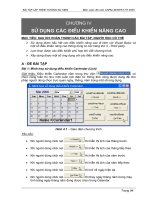Chuong 4 multicasting
Bạn đang xem bản rút gọn của tài liệu. Xem và tải ngay bản đầy đủ của tài liệu tại đây (3.39 MB, 41 trang )
Chapter 15
Multicasting and
Multicast Routing Protocols
Objectives
Upon completion you will be able to:
• Differentiate between a unicast, multicast, and broadcast message
• Know the many applications of multicasting
• Understand multicast link state routing and MOSPF
• Understand multicast link state routing and DVMRP
• Understand the Core-Based Tree Protocol
• Understand the Protocol Independent Multicast Protocols
• Understand the MBONE concept
TCP/IP Protocol Suite
1
15.1 UNICAST, MULTICAST,
AND BROADCAST
A message can be unicast, multicast, or broadcast. Let us clarify these
terms as they relate to the Internet.
The topics discussed in this section include:
Unicasting
Multicasting
Broadcasting
Multicasting versus Multiple Unicasting
TCP/IP Protocol Suite
2
Figure 15.1 Unicasting
TCP/IP Protocol Suite
3
Note:
In unicasting, the router forwards the
received packet through only
one of its interfaces.
TCP/IP Protocol Suite
4
Figure 15.2 Multicasting
TCP/IP Protocol Suite
5
Note:
In multicasting, the router may
forward the received packet
through several of its interfaces.
TCP/IP Protocol Suite
6
Figure 15.3 Multicasting versus multiple unicasting
TCP/IP Protocol Suite
7
Note:
Emulation of multicasting through
multiple unicasting is not efficient and
may create long delays, particularly
with a large group.
TCP/IP Protocol Suite
8
15.2 MULTICAST APPLICATIONS
Multicasting has many applications today such as access to distributed
databases, information dissemination, teleconferencing, and distance
learning.
The topics discussed in this section include:
Access to Distributed Databases
Information Dissemination
Dissemination of News
Teleconferencing
Distance Learning
TCP/IP Protocol Suite
9
15.3 MULTICAST ROUTING
In this section, we first discuss the idea of optimal routing, common in
all multicast protocols. We then give an overview of multicast routing
protocols.
The topics discussed in this section include:
Optimal Routing: Shortest Path Trees
Routing Protocols
TCP/IP Protocol Suite
10
Note:
In unicast routing, each router in the
domain has a table that defines a
shortest path tree to possible
destinations.
TCP/IP Protocol Suite
11
Figure 15.4 Shortest path tree in unicast routing
TCP/IP Protocol Suite
12
Note:
In multicast routing, each involved
router needs to construct a shortest
path tree for each group.
TCP/IP Protocol Suite
13
Note:
In the source-based tree approach,
each router needs to have one shortest
path tree for each group.
TCP/IP Protocol Suite
14
Figure 15.5 Source-based tree approach
TCP/IP Protocol Suite
15
Figure 15.6 Group-shared tree approach
TCP/IP Protocol Suite
16
Note:
In the group-shared tree approach,
only the core router, which has a
shortest path tree for each group, is
involved in multicasting.
TCP/IP Protocol Suite
17
Figure 15.7 Taxonomy of common multicast protocols
TCP/IP Protocol Suite
18
15.4 MULTICAST LINK STATE
ROUTING: MOSPF
In this section, we briefly discuss multicast link state routing and its
implementation in the Internet, MOSPF.
The topics discussed in this section include:
Multicast Link State Routing
MOSPF
TCP/IP Protocol Suite
19
Note:
Multicast link state routing uses the
source-based tree approach.
TCP/IP Protocol Suite
20
15.5 MULTICAST DISTANCE
VECTOR: DVMRP
In this section, we briefly discuss multicast distance vector routing and
its implementation in the Internet, DVMRP.
The topics discussed in this section include:
Multicast Distance Vector Routing
DVMRP
TCP/IP Protocol Suite
21
Note:
Flooding broadcasts packets, but
creates loops in the systems.
TCP/IP Protocol Suite
22
Note:
RPF eliminates the loop in the
flooding process.
TCP/IP Protocol Suite
23
Figure 15.8 RPF
TCP/IP Protocol Suite
24
Figure 15.9 Problem with RPF
TCP/IP Protocol Suite
25









